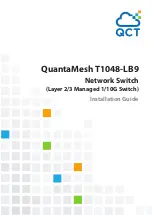
13-12
Configuring Port-Based and User-Based Access Control (802.1X)
General Operating Rules and Notes
■
If a port on switch “A” is configured as an 802.1X supplicant and is
connected to a port on another switch, “B”, that is not 802.1X-aware,
access to switch “B” will occur without 802.1X security protection.
■
On a port configured for 802.1X with RADIUS authentication, if the
RADIUS server specifies a VLAN for the supplicant and the port is a trunk
member, the port will be blocked. If the port is later removed from the
trunk, the port will allow authentication of the supplicant. Similarly, if the
supplicant is authenticated and later the port becomes a trunk member,
the port will be blocked. If the port is then removed from the trunk, it will
allow the supplicant to re-authenticate.
■
If a client already has access to a switch port when you configure the port
for 802.1X authenticator operation, the port will block the client from
further network access until it can be authenticated.
■
Meshing is not supported on ports configured for 802.1X port-access
security.
■
A port can be configured as an authenticator
or
an 802.1X supplicant, or
both. Some configuration instances block traffic flow or allow traffic to
flow without authentication. Refer to “Configuring Switch Ports To Oper-
ate As Supplicants for 802.1X Connections to Other Switches” on page 13-
51.
■
To help maintain security, 802.1X and LACP cannot both be enabled on
the same port. If you try to configure 802.1X on a port already configured
for LACP (or the reverse) you will see a message similar to the following:
Error configuring port
X
: LACP and 802.1X cannot be run together.
Applying Web Authentication or MAC Authentication Concurrently
with Port-Based 802.1X Authentication:
While 802.1X port-based access
control can operate concurrently with Web Authentication or MAC Authenti-
cation, port-based access control is subordinate to Web-Auth and MAC-Auth
operation. If 802.1X operates in port-based mode and MAC or Web authenti-
cation is enabled on the same port, any 802.1X authentication has no effect on
the ability of a client to access the controlled port. That is, the client’s access
will be denied until the client authenticates through Web-Auth or MAC-Auth
on the port. Note also that a client authenticating with port-based 802.1X does
not open the port in the same way that it would if Web-Auth or MAC-Auth were
not enabled. That is, any non-authenticating client attempting to access the
port after another client authenticates with port-based 802.1X would still have
to authenticate through Web-Auth or MAC-Auth.
Содержание E3800 Series
Страница 1: ...HP Switch Software E3800 switches Software version KA 15 03 September 2011 Access Security Guide ...
Страница 2: ......
Страница 3: ...HP Networking E3800 Switches Access Security Guide September 2011 KA 15 03 ...
Страница 30: ...xxviii ...
Страница 86: ...2 36 Configuring Username and Password Security Password Recovery ...
Страница 186: ...4 72 Web and MAC Authentication Client Status ...
Страница 290: ...6 74 RADIUS Authentication Authorization and Accounting Dynamic Removal of Authentication Limits ...
Страница 364: ...8 32 Configuring Secure Shell SSH Messages Related to SSH Operation ...
Страница 510: ...10 130 IPv4 Access Control Lists ACLs General ACL Operating Notes ...
Страница 548: ...11 38 Configuring Advanced Threat Protection Using the Instrumentation Monitor ...
Страница 572: ...12 24 Traffic Security Filters and Monitors Configuring Traffic Security Filters ...
Страница 659: ...14 11 Configuring and Monitoring Port Security Port Security Figure 14 5 Examples of Show Mac Address Outputs ...
Страница 730: ...20 Index ...
Страница 731: ......
















































